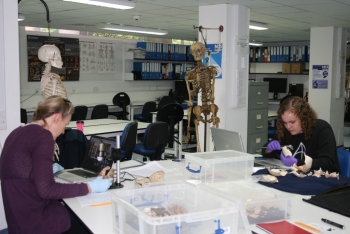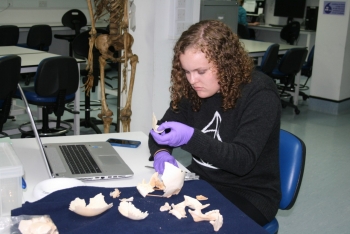Research could help prevent fatal outcomes of pediatric blunt force trauma

Research recently conducted by Drs. Donna and Cliff Boyd, co-directors of Radford University’s Forensic Science Institute (RUFSI), and senior anthropological sciences major Kimber Cheek could help mitigate and perhaps prevent the fatal outcomes of pediatric blunt force trauma.
This summer, the Boyds and Cheek traveled to the Centre for Anatomy and Human Identification at the University of Dundee, Scotland. There, they analyzed infant cranial remains from the Scheuer Collection, the largest collection of skeletonized juvenile remains in the world. Their research was focused on determining the effect of cranial thickness and architecture upon blunt force trauma outcome (fatality) in non-accidental pediatric (i.e., child abuse) cases.
“At the medical examiner’s office for which I work, we are seeing an increasing number of pediatric deaths from cranial hemorrhage due to child abuse,” Donna Boyd explained. “We hope to use this research to try to address this trend.”
In a study titled “The Influence of Three-Layered Cranial Architecture Development on Non-Accidental Pediatric Cranial Blunt Force Trauma Outcomes,” the Radford research team noted that approximately 75 to 80 percent of all non-accidental pediatric deaths involve cranial blunt force trauma, disproportionately affecting decedents below the age of 1 year.
Normal adult crania, Donna Boyd explained, are made of a three-layer architecture: the diploe, inner and outer table, which offers some protection from the effects of blunt force trauma. However, this architecture does not develop until sometime during the first or second year of an infant’s life, and a mature structure may not be present until later in childhood.
Of the infant fatalities the Boyds have seen, and oftentimes, had to testify about in court, the cause of death is usually cranial hemorrhage – or, bleeding of the brain, - and cranial fracture. This trauma can be caused by a number of factors, including even moderate shaking of the infant.
“This can be very, very harmful,” Donna Boyd said.

This research, in collaboration with the FSI, forms part of Cheek’s Summer Undergraduate Research Fellowship (SURF) as well as her honors capstone project. The research team has already noted that the three-layered architecture beings to appear in the first year of life.
Cheek wanted to know more.
To further understand the development of the cranium, the Radford research team spent hours analyzing and collecting samples of juvenile crania from the Scheuer Collection over a four-day period.
The 50 samples they collected ranged in age from perinatal to 17 years; 37 of the crania were below the age of 5 years. Variables across the sample included age; bone; bone location; bone maximum, mean and minimum thickness; inner and outer table differentiation; and diploe presence and morphology. Three hundred micrographs of internal bone structure were collected and later compared to seven non-accidental pediatric blunt force trauma cases the Radford team had been analyzing at the university’s RUFSI.
Their initial results indicate the absence of a three-layered cranial architecture until an infant reaches 4 to 6 months of age. A more mature cranial architecture pattern is not seen until 8 years of age.
“These results have real application to not only understanding fatal blunt force trauma outcomes, but also child mortality prevention,” Donna Boyd said.
The Boyds said they witness at the Virginia Office of the Chief Medical Examnier similar stories of such unfortunate cases time and time again.
“In a lot of cases, the perpetrator didn’t set out to kill,” Donna Boyd explained. “It’s a culture of punishment and abuse, a lack of education on the dangerous effects of blunt force trauma…There’s also an anger management aspect to this, and oftentimes, drug abuse. A toxic combination of events leads to the same results every time.”
“Once we get a better appreciation and understanding of these results and we can map out the very sensitive and vulnerable areas of the cranium, we would like to promote public education about the risks of blunt force trauma to child mortality.”
Donna Boyd said the research team has applied for a $200,000 grant from the National Institute of Justice to assist in this public education endeavor and will present the results of their research at the upcoming American Academy of Forensic Sciences meeting in Seattle.
Cheek, of Fredericksburg, is on track to graduate this spring and has had several impressive internships during her Radford University tenure. She plans to pursue graduate school and a Ph.D. in anthropology. Her dream job is to work for the Defense POW/MIA Accounting Agency.
“Kimber is intelligent and hard-working and well-equipped to work in this field,” Donna Boyd. “As educators, our goal is to provide students, such as Kimber, with the hands-on training and research that gives them the edge to be competitive professionals. Kimber has definitely represented Radford University well.”